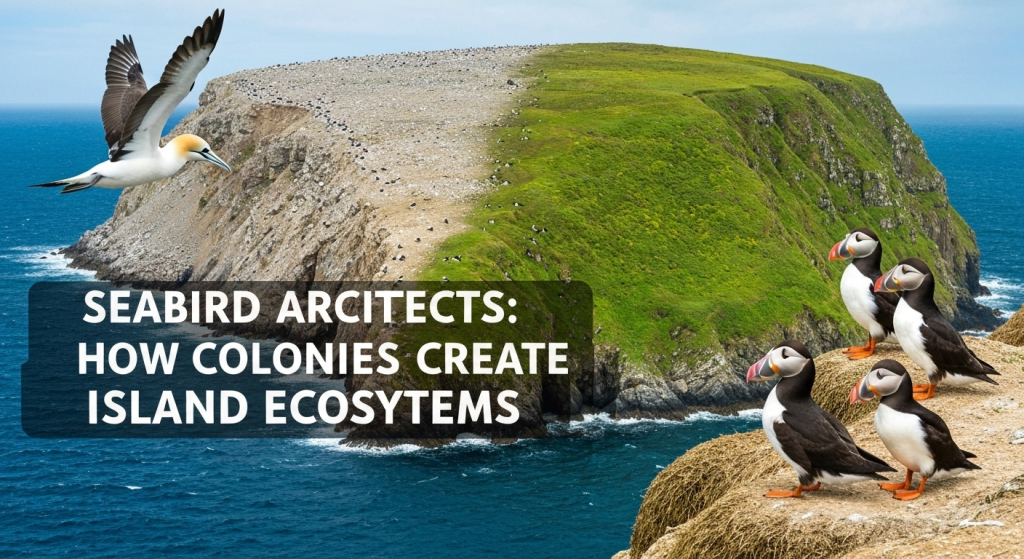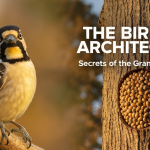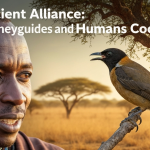Walk along the coast of a remote, rocky island, and you might be overwhelmed by the sights and sounds. Thousands of seabirds—puffins, gannets, or murres—wheel through the sky, their calls echoing off the cliffs. They are the island’s most obvious inhabitants. But what’s less obvious is that they aren’t just living there; they are actively building the island’s entire ecosystem from the ground up. These birds are the unsung engineers of some of the most fertile and vibrant coastal habitats on Earth. Through a surprisingly simple process, they transport the ocean’s wealth onto barren land, kickstarting a chain reaction that transforms rock into a rich, living landscape.
This article breaks down the science behind this incredible transformation. We’ll explore the powerful chemistry of their droppings, known as guano, and see how it completely alters the soil. We will trace how this nutrient bomb fuels a boom in plant and insect life, creating a complex food web where one would not otherwise exist. It’s a fascinating story of ecological engineering, showing how the daily habits of a bird colony can have profound and lasting impacts on the world around them.
As an author and observer of the natural world, my fascination with these dynamic systems began years ago. My name is Mahnoor Farooq, and for over five years, I’ve been exploring and writing about the intricate lives of bird species. My work isn’t about formal credentials but about a deep-seated curiosity to understand the why behind animal behaviors. Standing on the edge of a seabird colony, feeling the energy and seeing the stark line between the birds’ domain and the untouched land, provides a powerful lesson in ecology. It’s this first-hand experience—seeing, smelling, and documenting these environments—that I aim to share with you, bringing the science out of the textbooks and into the real world.
The Great Nutrient Pump: Moving the Ocean onto Land
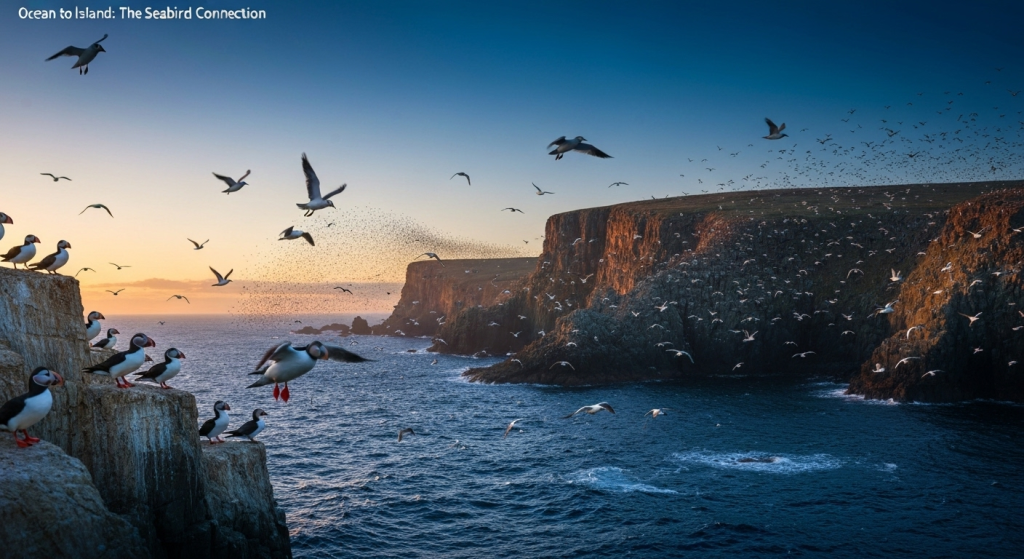
At its core, the transformation of an island by seabirds is about one simple, powerful process: marine-to-terrestrial nutrient transfer. Think of it like a biological conveyor belt. Seabirds, such as puffins, cormorants, and albatrosses, spend most of their lives foraging in the open ocean. This marine environment is incredibly rich in life and, therefore, nutrients. The birds feed on fish, krill, and squid, which are packed with essential elements that are often scarce on land.
When these birds return to their island colonies to nest, rest, and raise their young, they bring those oceanic nutrients with them. They then deposit them on the island in several ways:
- Guano (Droppings): This is the most significant method of transfer. Seabird droppings are highly concentrated packets of nutrients.
- Feathers: Molted feathers slowly decompose, releasing their stored nutrients into the soil.
- Eggshells: Discarded or broken eggshells contribute calcium and other minerals.
- Carcasses: Birds that die on the island naturally decompose, returning their body’s nutrients to the ecosystem.
The key elements being moved are the building blocks of life: nitrogen (N) and phosphorus (P). In the ocean, these elements are abundant, but on a windswept, rocky island, they are often the main factors limiting plant growth. The constant, daily arrival of thousands of birds creates a steady stream of these nutrients, turning a barren landscape into a potential garden. I once witnessed a colony of Common Murres where the rocks were stained completely white; it looked like a permanent snowfield, but it was actually a massive, active layer of nutrient deposition in progress. This is the foundation of the entire system—a relentless pump moving life-sustaining elements from one environment to another.
Guano: Nature’s High-Potency Fertilizer
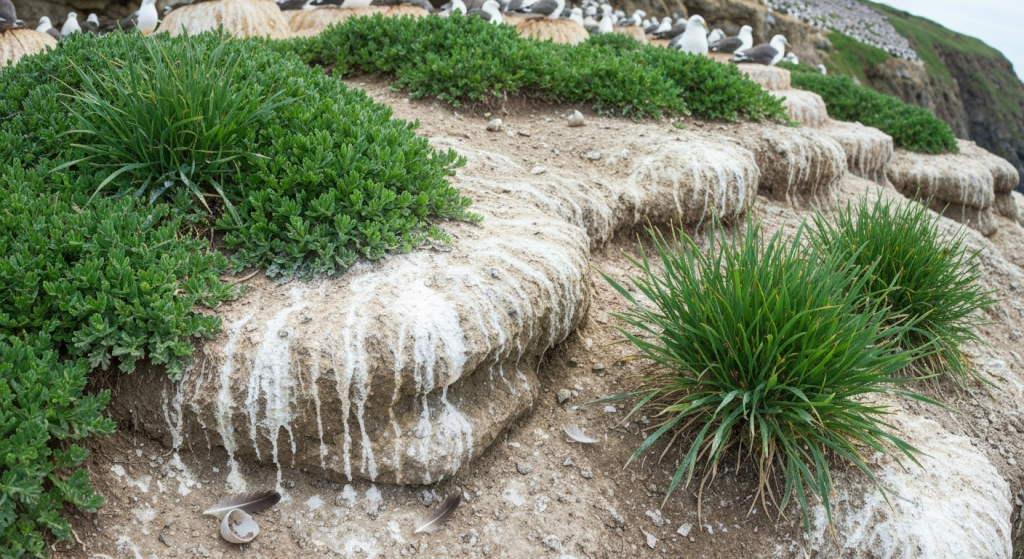
While feathers and carcasses contribute, the real engine of change is guano. The term comes from the Quechua word wanu, meaning “dung,” and for centuries, it was so valued as a fertilizer that nations went to war over it. The reason it’s so powerful lies in its unique chemical composition, which is a direct result of the seabirds’ diet.
Unlike the droppings of land-based herbivores, which are mostly digested plant matter, seabird guano is derived from marine protein. This makes it exceptionally rich in specific compounds:
- Nitrogen: The guano is full of uric acid, a nitrogen-rich compound that is far more concentrated than the urea found in mammalian urine. When bacteria break this down, it releases a massive amount of nitrogen that plants can use.
- Phosphorus: Fish bones are rich in calcium phosphate. When seabirds digest fish, this phosphorus becomes concentrated in their guano, providing another essential nutrient that is often locked away and unavailable in island soils.
The sheer volume of this deposition is staggering. Scientific studies have measured the nutrient input in some colonies at over 1,000 kilograms of nitrogen per hectare per year. To put that in perspective, that is significantly more than the application rates used in intensive agriculture. This isn’t just fertilizing the soil; it’s completely redefining its chemical nature. The high concentration of ammonia from the breakdown of uric acid also makes the soil more acidic, which further influences what can grow there. The potent, ammonia-like smell of a seabird colony is the scent of an ecosystem being built.
The Nitrogen Cycle Supercharged
On a typical patch of land, the nitrogen cycle is a slow, closed loop. Nitrogen is fixed from the atmosphere, used by plants, eaten by animals, and returned to the soil upon death. Seabirds completely bypass this slow process. They act as a massive external input, injecting huge quantities of ready-to-use nitrogen into the system.
Let’s break down what happens:
- Deposition: A bird deposits guano, which is rich in uric acid (
).
- Ammonification: Soil bacteria and fungi get to work, breaking down the uric acid and other complex proteins. This process releases ammonia (
), which then becomes ammonium ions (
) in the soil. This is the step responsible for the sharp smell.
- Nitrification: A different set of bacteria converts the ammonium into nitrites (
) and then, finally, into nitrates (
).
- Plant Uptake: Nitrates are the form of nitrogen that most plants can absorb most easily through their roots.
By importing the main ingredient (uric acid) in massive quantities, seabirds effectively supercharge this cycle, making an enormous amount of plant-available nitrogen available almost instantly.
From Barren Rock to Lush Landscapes: Transforming the Soil and Vegetation
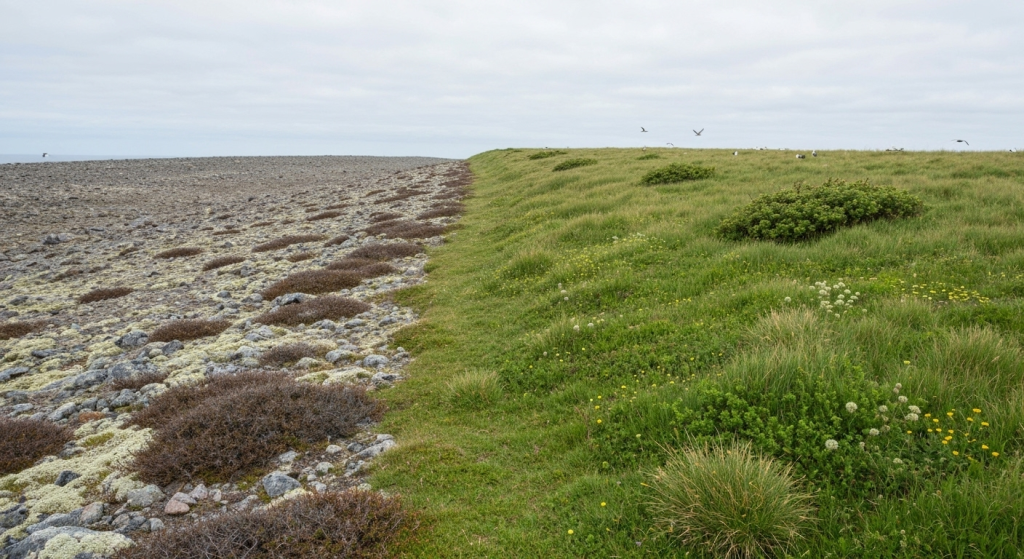
The intense nutrient enrichment from guano has a dramatic and visible effect on the island’s plant life. The original vegetation on many rocky islands is sparse, dominated by slow-growing species like lichens and hardy, low-lying plants that can survive in nutrient-poor conditions. The arrival of a seabird colony changes the rules of the game entirely.
The soil, now loaded with nitrogen and phosphorus, becomes a fertile ground for a completely different set of plants. These are often fast-growing, highly competitive species that thrive in high-nutrient environments. Botanists even have a name for them: ornithocoprophilous plants, which literally means “bird-dung-loving.”
This shift in vegetation is often so abrupt that you can see the boundary of the colony marked by the plant life. Within the colony’s sphere of influence, you’ll find dense thickets of grasses, docks, and other leafy green plants. Step a few meters outside this zone, and the vegetation might revert to sparse, rocky ground. During a trip to an island off the coast of Scotland, I saw this firsthand. The areas around the puffin burrows were covered in a carpet of lush, bright green sea campion and grasses. But just a short walk inland, away from the burrows, the landscape was dominated by purple-brown heather and tough, short grasses—a clear line drawn by the birds themselves.
The table below summarizes the key differences between areas influenced by seabirds and those that are not.
| Feature | Area Within a Seabird Colony | Area Outside a Seabird Colony |
| Soil Nitrogen Content | Extremely High | Very Low |
| Soil Phosphorus Content | Extremely High | Very Low |
| Soil pH Level | Lower (More Acidic) | Higher (Closer to Neutral) |
| Dominant Plant Types | Fast-growing, nitrogen-loving grasses and herbs. | Slow-growing lichens, mosses, and hardy shrubs. |
| Plant Biomass (Total Weight) | High; dense and tall vegetation. | Low; sparse and low-lying vegetation. |
| Species Diversity | Can be lower due to a few competitive species taking over. | Can be higher with a mix of specialized, slow-growing plants. |
This process isn’t just about adding new plants; it’s about creating a fundamentally different type of habitat. The dense vegetation provides more ground cover, which can reduce soil erosion and create a more humid microclimate, further benefiting the ecosystem.
The Ripple Effect: How Guano Fuels an Entire Island Food Web
The changes don’t stop with the plants. The transformation of the island’s flora sets off a chain reaction known as a trophic cascade, where the impact on one level of the food web ripples up to affect all the other levels. The seabirds are the keystone species, and their guano is the catalyst.
Here’s how the cascade unfolds:
A Boom for Herbivores
The new, lush vegetation provides an all-you-can-eat buffet for plant-eating invertebrates. Snails, slugs, mites, springtails, caterpillars, and other herbivores that were once limited by a lack of food now have a plentiful supply. Their populations explode. The soil itself, enriched with decaying organic matter from both guano and dead plants, also becomes a thriving habitat for decomposers like earthworms and beetles.
A Feast for Predators
With a booming population of invertebrates, the next trophic level—the predators—also benefits. The island becomes a paradise for spiders, predatory beetles, and centipedes. From my own observations, turning over a rock near a seabird colony often reveals a bustling community of insects and spiders, far more than you would find in the nutrient-poor areas. This abundance of insect life can also support larger animals, such as native lizards or small land birds like wrens and pipits, which may visit the colony specifically to feed on the rich supply of insects.
Connecting to the Sea Again
The influence of guano even extends back into the ocean. During heavy rains, the nutrient-rich soil from the island runs off into the surrounding coastal waters. This runoff acts as a fertilizer for the marine ecosystem, specifically for phytoplankton and algae. This localised algal bloom provides more food for small marine invertebrates, which in turn feed small fish. This creates a highly productive “halo” in the water immediately surrounding the island, which can then be an even richer foraging ground for the seabirds. It’s a perfect feedback loop: the birds fertilize the land, the land fertilizes the sea, and the sea feeds the birds.
This intricate web of life, from the soil microbes to the spiders in the grass to the fish in the coastal reef, is all built upon the foundation of guano deposited by the seabirds.
Frequently Asked Questions (FAQs)
Does all bird poop work the same way as seabird guano?
Not quite. While all bird droppings contain nitrogen, seabird guano is uniquely potent because of their diet of fish and krill. This marine-based diet concentrates nitrogen and phosphorus to a much higher degree than the seed- or insect-based diets of most land birds.
How long does it take for a seabird colony to change an island’s ecosystem?
The effects can be surprisingly fast. Visible changes in vegetation, such as greener and denser grasses, can often be seen within just a few nesting seasons. The more profound changes to soil chemistry and the establishment of a complex invertebrate community can take several years or decades, depending on the size of the colony and the island’s climate.
Can too much guano be a bad thing?
Yes. In very high concentrations, right in the center of a dense colony, the soil can become “hyper-eutrophied,” or over-fertilized. The extremely high levels of ammonia and acidity can be toxic to most plants, creating bare patches of “burnt” ground. However, it’s typically on the fringes of these zones where the vegetation is most lush.
Why was guano historically so important?
Before the invention of synthetic fertilizers in the early 20th century, guano was one of the most effective fertilizers known. Vast deposits, sometimes dozens of meters thick, accumulated over centuries on arid islands off the coast of Peru and in the Pacific. The mining of this “white gold” in the 19th century was a massive global industry, vital for agriculture in North America and Europe.
Conclusion: Architects of Life
Seabirds are far more than just inhabitants of the islands where they nest. They are powerful ecological architects. They tirelessly ferry the building blocks of life from the rich ocean depths to the barren land, initiating a cascade of biological activity. What begins as a simple dropping transforms the very chemistry of the soil, dictates which plants can grow, and in turn, builds an entire food web of insects and predators.
The vibrant green coasts, the buzzing of insects, and the complex web of life on these seabird islands are all a direct testament to this powerful connection between sea and land. It is a striking reminder that in nature, nothing exists in isolation. The actions of one group of animals can lay the foundation for thousands of other species, turning a lonely rock in the ocean into a thriving, self-sustaining world.
